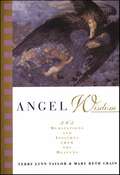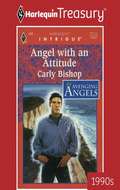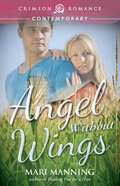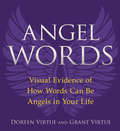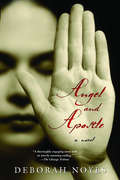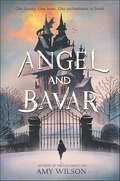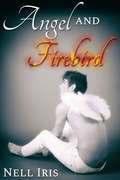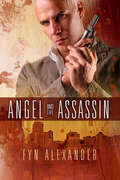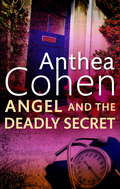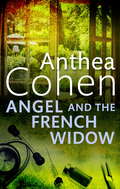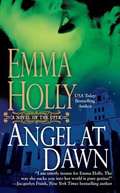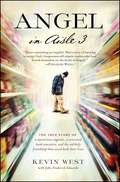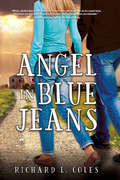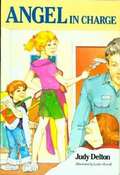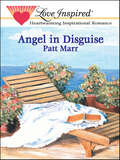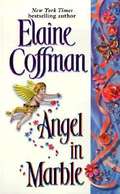- Table View
- List View
Angel Wisdom: 365 Meditations and Insights from the Heavens
by Terry Lynn TaylorLike a guardian angel whispering in your ear…'Angel Wisdom' puts you in touch with the warmth, encouragement, and insight of your heavenly helpers every day.Some say angels- intermediaries from on high- have always been among us to
Angel With An Attitude
by Carly BishopA five-hundred-year-old passion simmers on... As far as Angelo could figure, it must have been the sight of the orphaned baby that caused Isobel Avedon, his one true love, to turn irrevocably mortal. Isobel had always wanted a baby...his baby. During the half millenium that Isobel and Angelo had been separated, they hadn't once been tempted by sins of the flesh. But then, they'd both been angels. Now Isobel was mortal, and pent-up passion returned with a vengeance. Vengeance was apparently still on the killer's mind, too. Though Angelo should have assigned another halo to protect the baby and surrogate mom, he could trust no one with Isobel's life. He'd let her down once before and they'd both been murdered. He wasn't about to lost sight of her again. AVENGING ANGELS The sexiest angels this side of heaven!
Angel Without Mercy (Agnes Carmichael #1)
by Anthea CohenShe jabbed the pen angrily into the paper on which she was writing. No woman should bring as much unhappiness into a place as this woman does, she thought. The people she'd reported. Dear old Jones on the geriatric ward, he'd been up on a complaint, in front of the Committee, because of Miss Hughes. He'd nearly lost his job. Then there was the night cook, the one before Mrs. Upton. She'd been chucked out because Miss Hughes said she'd found her stealing food. She had too, but it was only the remains she'd been taking out. She had said it was for her cat or her dog, but Miss Hughes hadn't listened, she'd reported her, and she'd got the sack. There was no end to the harm Miss Hughes could do. Why? Why was she always on the look-out for something to report? She supposed to make herself look more efficient. There was the Creasey scandal and that man with the angina. There was one thing after another . . . I could kill her, she thought . . . from ANGEL without MERCY
Angel Without Wings
by Mari ManningA war widow at twenty-six, Linnea Reyes is haunted by the soul-shattering fight she had with her husband just before he led his detachment into the ambush that killed him. When one of the wounded soldiers asks her to help save his family's farm, she jumps at the chance for redemption. Unfortunately, she runs straight into a six-foot roadblock--the soldier's older brother who has plans of his own.After resigning from a promising army career to help his mother and wounded brother, Jesse McCormick is at the lowest point in his life. Now they are about to lose the family's organic farm and only one plan will earn him enough money to get his family out of debt and him out of the field--a dangerous assignment with a paramilitary group. He can brush aside the protests of his worried family, but the good intentions of Linnea Reyes prove too much to overcome.Sensuality Level: Sensual
Angel Without Wings
by Mari ManningA war widow at twenty-six, Linnea Reyes is haunted by the soul-shattering fight she had with her husband just before he led his detachment into the ambush that killed him. When one of the wounded soldiers asks her to help save his family's farm, she jumps at the chance for redemption. Unfortunately, she runs straight into a six-foot roadblock--the soldier's older brother who has plans of his own.After resigning from a promising army career to help his mother and wounded brother, Jesse McCormick is at the lowest point in his life. Now they are about to lose the family's organic farm and only one plan will earn him enough money to get his family out of debt and him out of the field--a dangerous assignment with a paramilitary group. He can brush aside the protests of his worried family, but the good intentions of Linnea Reyes prove too much to overcome.Sensuality Level: Sensual
Angel Without Wings
by Mari ManningA war widow at twenty-six, Linnea Reyes is haunted by the soul-shattering fight she had with her husband just before he led his detachment into the ambush that killed him. When one of the wounded soldiers asks her to help save his family’s farm, she jumps at the chance for redemption. Unfortunately, she runs straight into a six-foot roadblock—the soldier’s older brother who has plans of his own.After resigning from a promising army career to help his mother and wounded brother, Jesse McCormick is at the lowest point in his life. Now they are about to lose the family’s organic farm and only one plan will earn him enough money to get his family out of debt and him out of the field—a dangerous assignment with a paramilitary group. He can brush aside the protests of his worried family, but the good intentions of Linnea Reyes prove too much to overcome.Sensuality Level: Sensual
Angel Without Wings
by Mari ManningA war widow at twenty-six, Linnea Reyes is haunted by the soul-shattering fight she had with her husband just before he led his detachment into the ambush that killed him. When one of the wounded soldiers asks her to help save his family’s farm, she jumps at the chance for redemption. Unfortunately, she runs straight into a six-foot roadblock—the soldier’s older brother who has plans of his own.After resigning from a promising army career to help his mother and wounded brother, Jesse McCormick is at the lowest point in his life. Now they are about to lose the family’s organic farm and only one plan will earn him enough money to get his family out of debt and him out of the field—a dangerous assignment with a paramilitary group. He can brush aside the protests of his worried family, but the good intentions of Linnea Reyes prove too much to overcome.Sensuality Level: Sensual
Angel Words: Visual Evidence Of How Words Can Be Angels In Your Life
by Doreen Virtue Grant VirtueWhen Doreen and her son Grant Virtue were recording podcasts, they noticed that whenever she said the word angel, the recording graphics were shaped like angel wings! So they studied the other words she said and realized that those with a spiritual or loving basis had large graphs. So they experimented with saying negative words and found that their appearance was completely different: tight and small. Similar to Masaru Emoto's work with water crystals, Angel Words gives visual proof of the power and impact of speaking in a loving way. You'll come to understand why positive words express the most energy and therefore have the most power to manifest your dreams. You'll also see how negative words have low energy and read how they can actually draw negative experiences to you. This unforgettable book will immediately motivate you to choose positive words!
Angel and Apostle
by Deborah NoyesAt the end of Nathaniel Hawthorne's classic novel, The Scarlet Letter, we know that Pearl, the elf-child daughter of Hester Prynne, is somewhere in Europe, comfortable, well set, a mother herself now. But it could not have been easy for her to arrive at such a place, when she begins life as the bastard child of a woman publicly humiliated, again and again, in an unrelentingly judgmental Puritan world.With a brilliant and authentic sense of that time and place, Deborah Noyes envisions the path Pearl takes to make herself whole and to carve her place in the New World. Beautifully written with boundless compassion, Angel and Apostle is a heart-rending and imaginative debut in which Noyes masterfully makes Hawthorne's character her own.
Angel and Bavar
by Amy WilsonTaking inspiration from “Beauty and the Beast,” Amy Wilson’s second middle grade novel is a stunning modern fairy tale of magic, friendship, and finding the courage to fight for what matters most.After the death of her parents, Angel has a lot to get used to: a new home, a new family, a new school. The last thing she’s interested in is making new friends. Until she meets Bavar, a strange boy who slips through the shadows, a boy who might understand her nightmares. But Bavar doesn’t want to let anyone in. Everyone—and everything—in his enchanted house is already urging him to step up and protect the world from a magical rift and the fearsome monsters traveling through it, a responsibility he wishes he could ignore.Then Bavar discovers that the monsters are the same ones that killed Angel’s parents. Determined to stop the creatures for good, he reluctantly accepts Angel’s help. Together, Angel and Bavar must find the courage to stand up for each other and themselves to repair the rift between worlds…before it’s too late.
Angel and Firebird
by Nell IrisFive years ago, Phoenix lost his lover Gabriel, his angel, in a horrific hate crime. All Phoenix wanted was to follow Gabriel into death, and he struggled a long time trying to get his life back together. All this time later he still hasn’t been able to put the past behind him and forget about the love of his life.On the anniversary of Gabriel’s death, Phoenix’s apartment building catches fire. Will Phoenix do the reasonable thing and save himself, or can he rise from the ashes to reunite with his beloved angel?
Angel and the Assassin (Angel & The Assassin Ser. #Vol. 1)
by Fyn AlexanderKael Saunders loves to dominate handsome, masculine men like himself. Being in charge is his way of life, whether it be in his work with the secret intelligence service MI6, his empty and lonely personal life, or in the dungeon in his expensive flat on the River Thames. The last thing this no-nonsense, strict, and disciplined secret agent expects when he is out on a hit chasing down a gun runner is to fall in love with Angel Button, a young man desperate for the love and guidance of a Daddy.After spending his formatives years in foster care and then with his selfish, social-climbing mother and stepfather, Angel wants security, stability, and a man to love. However, Angel also has a passion for being spanked and restrained.Two very different men find love in a world of skilled assassins, Bosnian terrorists, and dungeon play. But can they make it work?
Angel and the Bear
by Brian CharltonA pinball wizard stars in this urban romance, set where the blues meet jazz in London, Ontario's historic York Hotel.
Angel and the Deadly Secret: The 17th Agnes Turner chiller (Agnes Carmichael #17)
by Ms Anthea CohenLife for Agnes Turner in her retirement is dull and uneventful. That is until she spots her mousy neighbour Amy Horrocks fleeing along the road in terror. When Agnes takes her in, Amy sobs out her distress: she is in fear of her life, harbouring a dark secret for which she is being blackmailed. Amy turns to Agnes for help, and Agnes, eternally supportive in the face of injustice, deals with the situation in her own, inimitable way.
Angel and the French Widow (Agnes Carmichael #16)
by Ms Anthea CohenThere is nothing Agnes Turner (née Carmichael) hates more than cruelty to animals. So when she sees a pup being abused by a boy she takes instant action. Days later her car is vandalised and so sure is she that the same boy is responsible that she takes the precaution of going to the police. However, when Agnes' French neighbour, a woman who bears a striking resemblance to Agnes, is found dead, a more direct approach is called for. The boy is a drug addict and careless so it isn't long before Agnes has a chance to dispense her own unique and deadly form of justice!
Angel at Dawn
by Emma HollyFive hundred years ago, Grace Gladwell had captured Christian Durand's heart and then abandoned him in his darkest hour. Seeing Grace again after all these years has sent Christian reeling-even though she seems to remember nothing of the medieval soldier, he wants her more than ever. But is Grace merely a pawn of the vampire queen who has set her immortal sights on Christian?
Angel at Her Shoulder: Lillian Dickson and Her Taiwan Mission
by Kenneth L. WilsonAngel at Her Shoulder is more than the title of an amazing story and the biography of a most remarkable, physically undersized but spiritually large woman. Lillian Dickson, the irresistible "Lil" of this book, who has been accurately named: "Typhoon Lil," has practiced and demonstrated the faith "once delivered" as no other mortal I have ever known. In these chapters we find her building hospitals, orphanages, schools, a leprosarium, churches, and mountain clinics with a courage that at times plunged ahead against what seemed to be, even to her most devoted associates, insuperable odds. This accurate and eloquently-written story tells the amazing record of this small woman, who was pyramid-high in love with the helpless and hapless. The author has been captured by his subject and Mrs. Dickson by Taiwan, South America, Mainland China, and the world could not have been more fortunate in her biographer.
Angel at Troublesome Creek: A Mystery (Augusta Goodnight Mysteries #1)
by Mignon F. BallardWhen Mary George Murphy finds that her Aunt Caroline fell down a flight of stairs to her death, she's heartbroken. To make matters worse, Mary is sure that Caroline's death was no accident. Enter Augusta Goodnight, Mary's guardian angel. Normally assigned to Heaven's strawberry fields, Augusta died during WWII -- which explains her old-fashioned glamour and love of swing. She appears in Troublesome Creek just in the nick of time-helping Mary unearth an old mystery and the truth about Caroline's death."Light, bouncy prose, small-town Southern perspective and characters, and a most fetching angel make this first volume in a new series a real charmer." - Library Journal
Angel in Aisle 3
by Kevin West Frederick EdwardsIn the tradition of An Invisible Thread and Same Kind of Different as Me, Angel in Aisle 3 is the heartwarming true story of an unlikely friendship that began with a chance meeting in a grocery store between a bank executive bound for prison and an elderly stranger.When Kevin West resigned from his job as vice president of a bank in 1998 after making fraudulent loans, he spent the time before his trial managing a family-owned, small grocery store in Ironton, Ohio. Dealing with serious marriage problems and with a prison sentence almost certainly in his future, Kevin was overcome with remorse and without a scrap of hope. It was at his lowest moment that Kevin called out to a power beyond himself for help, and God answered his prayer in the form of an elderly vagrant in a soiled shirt and tattered pants named Don. When Don saw Kevin's open Bible on the counter next to the register, the untidy, long-haired indigent took the opportunity to share Bible wisdom and life-giving truths that changed Kevin's life. Finding a sense of peace in their conversation, Kevin offered Don a few basic groceries and an invitation to continue their conversation the next day. What began as a chance meeting between two individuals whose lives seemed headed for certain ruin, turns into an unlikely bond of friendship that saved them both. It was this friendship that helped Kevin thrive in prison, restore his failed marriage, and gave Don a chance at a new life that went beyond anyone's imagination. Moving and awe-inspiring, this story of a pure friendship sheds light on the redemption and hope that can grow out of relationships based in faith.
Angel in Blue Jeans
by Richard L. ColesDana and Tony have found romance and they couldn't be happier with one another. Strolling home one icy evening, the young couple sees a police car pulling up in front of Tony's family home. Tony's brother along with Dana's brother had been drinking and driving that evening. And they're both dead. Elsewhere in the neighbourhood, Dave suddenly finds himself unemployed and scotch seems to do the trick of filling the void. He finds distraction in his pretty new neighbour, but he'd never hurt his wife--intentionally, that is. Angel in Blue Jeans follows the extraordinary lives of the ordinary people in a typical suburban neighbourhood grappling with the challenges of the modern day. Alcohol addictions, danger, and heartbreak are countered by strength, determination, and love. But do Dana, Tony, and Dave have the strength to endure?
Angel in Charge
by Judy Delton Leslie MorrillTen-year-old Angel and her little brother Rags have to cope with an incompetent babysitter and several crises while their mother is away.
Angel in Disguise
by Patt MarrBetrayed by her handsome fiancé, girls’ basketball coach Sunny Keegan knew for a fact that fairy tales faded. So when her rowdy team successfully challenged her to appear on Dream Date, Sunny gritted her teeth...and groaned when she “won” a date with blue-eyed, raven-haired Pete Maguire.Yet impossibly gorgeous carpenter Pete seemed a reluctant contestant, too, and Sunny sensed secrets behind his thousand-watt smile. Still, as he gently shepherded Sunny from hurt to hope, from loss to love, she began to wonder if she’d finally found Prince Charming. Or was Pete a heaven-sent angel in disguise?
Angel in Heavy Shoes (Katie Rose, Book #5)
by Lenora Mattingly WeberWhen the playwriting contest was announced at Adams High, Katie Rose Belford planned to spend the next, few days preparing her entry. She simply would not allow herself to be distracted by anyone else's problems. But fate and Katie Rose's sympathetic nature work against her. First, there was Rita Flood and her impossible family. The two older Flood boys had police records; Mrs. Flood drank too much; and Rita was concerned only about herself and her younger brother, Lennie. She tried to enlist Katie Rose's help in keeping the boy away from Irv, an older brother coming home from reform school. There were problems in the Belford household as well. Stacy, Katie Rose's younger sister, finds her romance with Bruce Seerie heading for the rocks. Bruce, conservative and aloof, cannot adjust to Stacy's goodnatured involvement with everyone she meets. Even reliable old Ben, the man of the fatherless Belford family, is preoccupied and moody. He is suddenly attracted to Holly, a carhop at the drive-in where he works to earn college tuition. Ben knows only too well that Holly is a slinky temptress who could mean trouble for him. Katie Rose's concern for those around her is shared by her quiet, steady friend, Miguel, and by her attractive young mother. In fact, it is Mrs. Belford's suggestion of an "uplift supper party" that brings everyone's problems to a head. Gay, impulsive, compassionate, and at times, a bit selfish, Katie Rose Belford is an engaging and realistic heroine. It is easy to see why each new story about her and her irrepressible family engenders new enthusiasm among the growing numbers of her readers.
Angel in Marble
by Elaine CoffmanIn 1836 a band of Comanche rode into Fort Parker, Texas, and kidnapped Margery Mackinnon, leaving her five big brothers orphaned. Like pollen borne by the wind, the brothers scattered to Nantucket, California, and Scotland while their sister wandered the plains, a captive traded from tribe to tribe. Now, in ANGEL IN MARBLE, we pick up the story of one of the Mackinnon brothers, Nick. With his silver tongue and the devil's own blue eyes, he has come to this Gulf town in Texas to build a ship. And he encounters his destiny in the feisty, hurt Tibbie Buchanan. For five years she's lived in a self-imposed prison, hiding from the past that betrayed her. She will yield to no man, yet day by day, Nick chips away at her defenses, at the wall of ice around her heart, determined to make the woman he loves trust him forever more.
Angel in Scarlet: A Bound and Determined Novel (Bound and Determined #4)
by Lavinia KentFrom the author of Mastering the Marquess comes another blazingly provocative Regency romance! Revenge may be a dish best served cold, but in this clash of wills, lust is a feast for the senses. After her dreams of wedding bells are dashed by a man she thought had serious intentions, Miss Angela Ripon must be satisfied. She plans to make him burn for her, and then to reject him as he rejected her. There's only one woman who can teach Angela that sort of seduction: Madame Rouge--or Ruby, to the men who frequent her house of pleasure. The infamous madam agrees to help, but only after warning Angela that her target has very specific tastes. To trap her prey, she must shed every last inhibition. Matthew Harkness, Earl of Colton, doesn't mean to hurt the young admirers who flock to him. He simply isn't interested in women who are too timid for his dark desires. He judged Angela to be like the others--tender, sweet, and innocent. So how to explain the change that has come over her? Matthew aches to teach Angela all he knows of earthly pleasures. But even as she offers the control he craves, perhaps this angelic beauty has a lesson or two to teach him. Angel in Scarlet is intended for mature audiences. This ebook includes a special message from the editor, as well as an excerpt from another Loveswept title. Praise for Lavinia Kent's Bound and Determined series "[A] tale of sexual exploration and liberation . . . the hottest historical romance story I've ever read."--Heroes and Heartbreakers, on Mastering the Marquess "Sexy, steamy . . . an entertaining read."--Guilty Pleasures Book Reviews, on Mastering the Marquess "A refined, sophisticated and tasteful historical romance . . . The mood is very seductive but still playful, and the sex scenes are scorching hot. . . . Revealing Ruby is superbly written, moves along quickly; it's a very enjoyable read."--Fresh Fiction, on Revealing Ruby "Ruby and Derek's chemistry is just as explosive during their unbridled trysts as with their slow, ardent lovemaking."--Library Journal, on Ravishing Ruby
